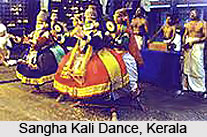 Sangha Kali is also known as `Sahastrakali`, `Chathirakali` or `Vatrakali`. Essentially, it is a dance having a socio-religious context. This was a very favourite and popular pastime of Namboothiris and it was performed as an offering to Goddess Kali. The origin of Sangha Kali may be deeply rooted in the numerous gymnasium techniques (known as `Kalaris`) in ancient Kerala where physical exercises and military training with special emphasis on physical feats and swordsmanship were given.
Sangha Kali is also known as `Sahastrakali`, `Chathirakali` or `Vatrakali`. Essentially, it is a dance having a socio-religious context. This was a very favourite and popular pastime of Namboothiris and it was performed as an offering to Goddess Kali. The origin of Sangha Kali may be deeply rooted in the numerous gymnasium techniques (known as `Kalaris`) in ancient Kerala where physical exercises and military training with special emphasis on physical feats and swordsmanship were given.
Celebrations on periodic basis were held in these Kalaris, where a special display of skill in weapons and the techniques of the learner could be put as a prologue. With the civilization and stabilization of the Aryan culture in the land, the Namboothiri Brahmins, who were the Aryan immigrants-entered these gymnasia and their participation and influence gave this celebration a religious colour.
For this dance, a number of people wear red scarves on the head and red cloths on the wrists and assemble in a group. The performance begins with steps of the gymnasia to the accompaniment of the instruments like `Chenda`, `Maddalam`, `Elethalam` and the gong. The dance has many phases of ritual worship, recital of devotional songs, pure dance, comic interludes, etc. They include the `Kottichakampookal`, `Kottiyarkal`, `Pana`, `Velichappadu`, `Nalupadam`, `Slokam`, `Neetuvayana`, `Kandappanpurappad`, `Poli Kaimalothika samvadam`, `Paradesipurappad` etc.
The last phase of the dance performance is very important and it is called `Kudameduppu`. It is military in character and is in the exercise form, displaying the skill in swordsmanship and the mastery of techniques in the use of other weapons. Among the dance phase in the Sangha Kali, the `Kurathiyattam` is the most graceful and famous step of this dance.



















